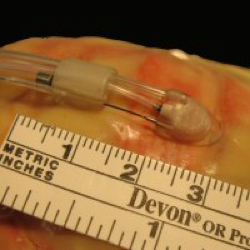
HeartLander is a miniature mobile robot designed to facilitate minimally invasive therapy to the surface of the beating heart. Under physician control, the robot:
- enters the chest through an incision below the sternum,
- adheres to the epicardial surface of the heart,
- autonomously navigates to the specified location, and
- administers the therapy.
As compared to robotics currently used in cardiac surgery, this novel paradigm offers several advantages by obviating cardiac stabilization, lung deflation, and access limitations. The result is a device that improves the precision and stability of interaction with the surface of the beating heart, while decreasing the morbidity associated with access.
The current tethered design uses suction to maintain prehension of the epicardial surface, and drive-wire actuation to provide locomotion. The physician controls the robot with a joystick interface while viewing a graphical representation of the robot on the heart that is generated using an onboard magnetic tracking sensor. The control system also uses these tracking data to provide autonomous navigation to the specified target. After the target has been acquired, the physician administers the therapy through the working channel of the robot.
 HeartLander has been evaluated through a series of studies on a closed-chest beating porcine model with the pericardium intact. The results demonstrated its ability to traverse the entire surface of the ventricles, to autonomously acquire target patterns with high accuracy, and to maintain stability. Additionally, preclinical feasibility studies have demonstrated myocardial injection of dye, epicardial lead placement, and epicardial ventricular ablation from HeartLander.
HeartLander has been evaluated through a series of studies on a closed-chest beating porcine model with the pericardium intact. The results demonstrated its ability to traverse the entire surface of the ventricles, to autonomously acquire target patterns with high accuracy, and to maintain stability. Additionally, preclinical feasibility studies have demonstrated myocardial injection of dye, epicardial lead placement, and epicardial ventricular ablation from HeartLander.
